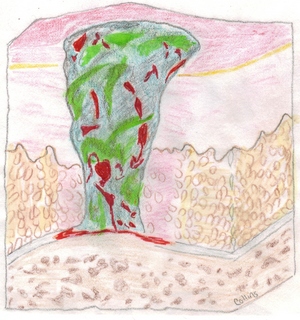The prevention of decubitus ulcers (bedsores) is one of the most important considerations in the nursing care of patients. It is a complication that in most instances is due to poor nursing care. Such a sore is due to pressure that produces ischemia and consequently impaired nutrition to the tissues. This deprivation causes the cutaneous tissues to be broken or destroyed, and there is a progressive destruction of underlying soft tissue. The ulcer may be extremely painful and very slow to heal. Bacterial invasion and secondary infection are difficult to avoid. The lesion, if large enough, permits a continuous loss of serum, which may deplete the circulating blood and the entire body of essential protein constituents.
Any patient who is stupors emaciated, incontinent, paralyzed, or whose treatment involves the immobilization of any portion of the body is in constant danger of developing a decubitus ulcer. Essentials of Prevention
The best treatment of decubitus is prevention. The principles that underlie the nursing management are (1) to relieve or to remove pressure, (2) to stimulate the circulation, and (3) to keep the skin dry.
The patient needs frequent changes of position and the avoidance of positions that result in excessive local pressure. He should be turned every 2 hours. If possible, he should be taught and encouraged to turn himself. Turning helps the tissue to recover from pressure. Localized pressure, for even a few hours, may cause cessation of blood flow in the capillary bed. Redness and edema are seen. Then, within a few days ulceration and skin necrosis follow.
Bony prominences may be protected by inserting small pieces of sheepskin pads (preferably) or foam rubber beneath the sacrum, the trochanters, the heels, the elbows, the scapulae and the back of the head when there is pressure on these sites. The use of a foot board removes the pressure of the bedding from the feet and the extremities. The alternating pressure pad mattress covered with one-inch thick foam rubber is especially valuable in conditions in which the patient cannot turn. The alternating inflation and deflation of the pad produces a constriction followed by a dilatation of the superficial blood vessels of the skin. By such action, pressure on any one part is reduced and the blood supply is increased.
Since the stimulation of circulation relieves tissue ischemia, the forerunner of decubitus ulcers, the patient is encouraged to keep active. (Activity also stimulates the metabolic processes and helps to improve morale.) Frequent skin massage is useful as a means of stimulating the blood flow in the skin. A gentle circular motion is used around bony prominences and other vulnerable areas. If an abrasion is discovered, massage should be directed in ever-widening circles away from the lesion. Again, turning aids the circulation. The use of a rocking bed and a tilt table also aids in stimulating circulation.
Maceration of the skin by continuous moisture must be prevented by meticulous hygienic measures. The skin should be washed with a mild soap (or one containing hexachiorophene to reduce bacterial infection) and water and blotted dry with a soft towel. The skin then is lubricated with an emollient lotion to keep it soft and pliable. It is desirable that the patient assist in caring for his skin. He should be taught to inspect it at frequent intervals for evidence of pressure. Foreign bodies should be kept out of the bed because they serve to irritate the skin. Foundation sheets should be tightly stretched to prevent wrinkles.
If a decubitus ulcer develops, the essentials of care are to remove the pressure and to keep the area clean and dry. The metabolic processes are stimulated by keeping the patient as active as possible. Blood flow may be improved by gentle massage to the adjacent area. The patient is placed on a high protein diet to promote healing.
Plasma, blood, sugar and other nutrients have been employed to encourage healing of the wound. Many clinicians and investigators feel that proteolytic enzymes have a significant place in the management of these wounds. However, 2 factors are always necessary for the successful healing of a decubitus ulcer: (1) avoidance of further pressure and (2) keeping the wound well derided and clean.
Flotation Therapy a device recently developed reduce pressure is the water bed. The patient is supported on a plastic tarpaulin. The tarpaulin rests on water and the patient floats freely in the water. The underlying principles are those of flotation and displacement: the body literally gives up its weight when it is partially submerged in water. Thus, the body weight is lightened and there is less pressure on body parts as the body floats in the water. Beds of varying designs are available; some permit the patient to assume a sitting position so he can carry out divisional and other activities. Flotation therapy has proved to be an effective and safe treatment for decubitus ulcers. For deep decubitus that refuse to heal by conservative means, some advocate excision of the ulcer and often of the underlying bony prominence, with plastic closure by skin and fat flaps.
Source: Brem H, Kirsner RS, Falanga V (2004). “Protocol for the successful treatment of venous ulcers”. Am. J. Surg.188 (1A Suppl): 1-8.


